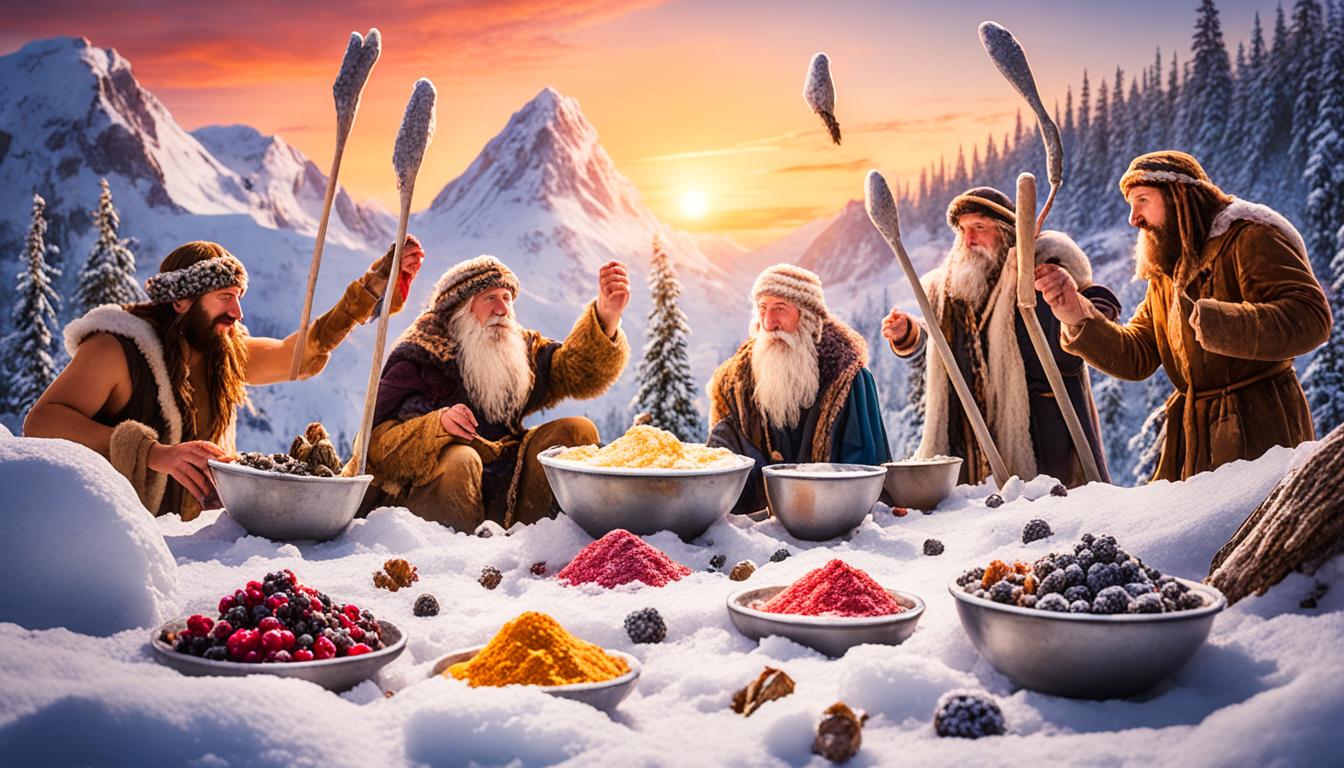As you dip your spoon into a creamy scoop of ice cream, memories often come flooding back—warm summer days spent laughing with friends, family gatherings filled with the delightful sound of a scoop diving into a bowl, or perhaps the quiet joy of indulging in your favorite flavor after a long day. But have you ever wondered about the journey of this beloved frozen dessert? The ice cream origins are steeped in rich history and culture that span thousands of years, making every bite a sweet taste of the past. From ancient civilizations experimenting with frozen concoctions to modern-day flavors that dazzle your palate, the history of ice cream reflects the creativity and innovation of countless cultures. Join us as we explore the captivating story of where does ice cream come from and uncover the delicious legacy that makes it a cherished treat around the globe.
Key Takeaways
- Ice cream is believed to have been invented around 4,000 BCE.
- The first known recipes of sherbet-like treats gained popularity in the Medieval Islamic world.
- The term “ice cream” first appeared in written English records in 1672.
- The first ice cream parlor in America opened in New York City in 1776.
- Catherine de Medici played a significant role in bringing frozen desserts to France.
- George Washington had a mechanical ice cream maker at Mount Vernon.
- The ice cream sundae’s origin remains a topic of historical debate.
The Fascinating History of Ice Cream
The journey of ice cream is as captivating as its creamy texture and delightful flavors. The origins of frozen desserts stretch back thousands of years, rooted in ancient cultures that found ways to enjoy icy treats. From Mesopotamia to the tables of emperors, frozen delicacies have held a place of admiration throughout history.
Ancient Treats and Their Origins
Early references to frozen desserts can be found in various civilizations. It’s believed that the origins of frozen desserts emerged from the creation of chilled treats made from snow and flavored with honey. In China, the 7th century marked the oldest known description of a frozen milk product. Documents from the 12th century further mention frozen milk, highlighting the creativity and innovation of ancient cultures. While the common ice cream we know today was yet to be developed, these early forms were essential in shaping the evolution of frozen delights.
The First Ice Houses in Mesopotamia
In Mesopotamia, early ice houses were built to preserve snow, which allowed for the cooling of beverages and the creation of refreshing frozen delicacies. These ice houses provided a glimpse into the early ice cream history, showcasing human ingenuity in utilizing natural resources to create enjoyable treats. The ability to store and enjoy frozen delights paved the way for the indulgent ice creams we savor today. Thus, the stage was set for the long-standing love affair with ice cream that would span cultures and centuries.

Where Does Ice Cream Come From?
The origins of ice cream are filled with fascinating tales and intriguing myths. Understanding the journey of ice cream reveals how this delightful treat has evolved over centuries. From ancient civilizations to modern culinary innovations, many legends and historical figures have been credited with its invention.
Legend vs. Reality: The Myths of Ice Cream’s Invention
Numerous stories surround the myths of ice cream invention. Some links credit Marco Polo for bringing a precursor of ice cream from Asia to Europe during his explorations in the 13th century. Others attribute its introduction in France to Catherine de’ Medici in the 16th century. While these narratives add a hint of glamour, the reality is more complex. Evidence suggests that iced drinks and desserts have existed since at least 4000 B.C. The Roman emperor Nero (A.D. 37–67) famously indulged in iced refreshments mixed with honey, marking some of the earliest known uses of ice in culinary creations.
The Journey from the East to the West
The journey of ice cream shifted significantly over the centuries. In ancient China, recipes detailed a sweet concoction made from iced, camphor-laced water buffalo milk, originating from the Tang dynasty. This early form of frozen dessert traveled westward, influencing Middle Eastern and European variations. By the early 1600s, Italian chefs crafted the first European ice creams and water ices, laying the groundwork for modern recipes.
A major turning point came in the 18th century with advancements in technology. George Washington’s purchase of a mechanical ice cream maker in 1784 underscores the growing popularity of this sweet treat. Likewise, Thomas Jefferson served it numerous times during his presidency, showcasing its status in American culture. The introduction of the waffle cone at the 1904 St. Louis World’s Fair marked another milestone in the evolution of ice cream, further solidifying its place in the culinary world.

| Year | Event | Details |
|---|---|---|
| 4000 B.C. | Origins of Iced Desserts | Evidence of early iced drinks and desserts. |
| A.D. 37–67 | Nero’s Iced Refreshments | Enjoyment of honey-laced iced desserts. |
| 16th Century | Tang Dynasty Innovation | Sweet iced drinks made from water buffalo milk. |
| 1600s | Early European Ice Creams | First recipes emerging in Italy. |
| 1784 | Washington’s Ice Cream Maker | Purchase highlighting its popularity. |
| 1904 | Waffle Cone Introduction | First appearance at the St. Louis World’s Fair. |
The Role of Ancient Cultures in Ice Cream Development
Exploring the roots of ancient cultures and ice cream reveals a rich tapestry of innovations and techniques that shaped the delights we indulge in today. Cultures across the globe laid the groundwork for frozen desserts history, particularly through the pioneering methods developed in China and the Persian Empire.
Chinese Innovations and the Tang Dynasty
The Tang Dynasty (618–907 AD) marks a significant chapter in the frozen dessert saga. Ancient Chinese techniques incorporated snow and saltpeter, creating a primitive refrigeration method. They fashioned a cold nectar from flour, camphor, water, and buffalo milk, showcasing early ingenuity in dessert preparation. This innovation hints at an ancestral form of ice cream that would eventually find its way into global culinary traditions.
Pertinent Contributions from the Persian Empire
The Persian Empire’s culinary creativity brought about notable contributions like faloodeh and sorbet. These frozen delights utilized advanced cooling techniques and ingredients available in ancient Persia. As trade routes flourished, so did the recipes and preparation styles, weaving the threads of cultures together and influencing European desserts. The burgeoning frozen desserts history in the Persian era cannot be overstated, as it cultivated a foundation for many modern confections you enjoy today.

The Influence of European Royalty on Ice Cream
European royalty played a significant role in integrating ice cream into cultural gourmet traditions. The luxury of icy desserts found its way to France through Catherine de Medici in the 16th century. Upon her marriage to King Henry II, she introduced Italian culinary customs that included a taste for frozen treats. This brought the concept of the European royalty ice cream influence to the forefront of French cuisine.
Catherine de Medici and Her Impact on French Cuisine
Catherine de Medici significantly shaped French gastronomy during her reign, promoting the use of high-quality ingredients and innovative cooking methods. Her passion for festivities and royal banquets helped ice cream evolve from a mere novelty to a lavish indulgence. Known for her elaborate seeds of culinary sophistication, Catherine’s influence led to ice cream becoming synonymous with elegance in French court life.
Ice Cream in 17th Century England and the Table of Charles I
The relationship between European royalty and ice cream thrived further in 17th century England. King Charles I was among the first British monarchs to relish this delightful treat. Under his reign, ice cream gained prominence among the aristocracy, becoming a must-have delicacy at royal gatherings. The sumptuous experience of savoring ice cream reflected the opulent lifestyle of English royalty. As a result, the European royalty ice cream influence set a trend that would resonate through history, establishing ice cream as a staple for the elite and eventually the masses.

Ice Cream in America: From Introduction to Popularization
The journey of ice cream in America began in the colonial era, establishing a love affair with this delightful dessert that has only grown over time. The narrative of American ice cream history reveals how this treat evolved from a rarity to a staple of American culture. You might be surprised by the rich details behind its introduction and how it became beloved by many.
The First Account of Ice Cream in Colonial Maryland
Records indicate that the first account of ice cream in America emerged as early as 1744, when it was mentioned in a letter connected to the governor of Maryland. This fascinating glimpse into early American ice cream history highlights its status as a luxury item, often reserved for the elite. French cookbooks started including ice cream recipes in the late 17th century, and it wasn’t long before similar entries started appearing in American cookbooks.
George Washington’s Affection for Ice Cream
George Washington became one of the earliest American icons associated with ice cream in America. His enthusiasm for the dessert was evident as he reportedly spent around two hundred dollars on ice cream in the summer of 1790, an astonishing sum that translates to roughly six thousand dollars today. In addition to Washington, Thomas Jefferson played a pivotal role in promoting ice cream, famously having ice molds shipped from France. Under his presidency from 1801 to 1809, ice cream was served at least six times at the President’s House, especially in pastries and crusts, showcasing its growing popularity.

| Year | Event | Details |
|---|---|---|
| 1744 | First account of ice cream | Documented mention in a letter related to Maryland’s governor. |
| 1792 | First ice cream recipe | Published in Richard Briggs’s The New Art of Cookery in Philadelphia. |
| 1824 | Introduction of multiple recipes | Mary Randolph included over twenty recipes in The Virginia House-Wife. |
| Late 18th Century | Jefferson’s influence | Had ice molds shipped back from France, served ice cream at White House. |
This historical context enriches your understanding of how ice cream transformed from an elite luxury to a cherished part of American social gatherings. Every scoop tells a story, connecting modern indulgences with the flavorful past of this iconic dessert.
The Evolution of Ice Cream Manufacturing
The ice cream production process underwent significant transformations in the 19th century, driven by technological innovations that changed the landscape of manufacturing. As the demand for this delightful treat increased, advancements in ice cream manufacturing brought about new methods that enhanced both efficiency and accessibility.
Advancements in Technology during the 19th Century
The 19th century was pivotal for ice cream, with inventions such as the artificial freezer, developed by Nancy M. Johnson in 1843. This innovation allowed for a more controlled and efficient freezing process, which was crucial for producing ice cream at scale. During this time, the Industrial Revolution facilitated the journey towards mass production, resulting in electric freezers that made ice cream more accessible to the general public.
Commercialization of Ice Cream Production
With the establishment of the first commercial ice cream factory by Jacob Fussell in 1851, the ice cream production process saw a significant shift. His efforts laid the foundation for commercial ice cream manufacturing in America, providing a steady supply of this beloved dessert. The successful commercialization during the late 19th century not only popularized ice cream but also set the stage for future brands to thrive in this expanding market.

Cultural Variations of Frozen Desserts
Frozen desserts encompass a fascinating array of cultural variations, showcasing how different regions have put their unique spin on icy treats. Each country offers a distinctive flavor profile and texture, contributing to the rich tapestry of global frozen desserts.
Persian Faloodeh and Its Legacy
One of the most beloved frozen desserts hails from Iran. Persian faloodeh consists of thin vermicelli noodles soaked in rose water and lime juice, served with a delightful syrup. This dish exemplifies ancient traditions and reflects the cultural variations of ice cream. Notable for its refreshing taste, faloodeh serves as a perfect antidote to warm weather. Its roots trace back centuries, providing a legacy that continues to delight people across the globe.
Italian Gelato Vs. American Ice Cream
Italian gelato is renowned for its creamier texture and stronger flavor compared to American ice cream. Gelato typically contains less air and fat, resulting in a denser product that is much richer. Mondo Gelato in San Diego brings this authentic Italian experience closer to home, featuring gelato that has half the fat and calories of traditional ice cream and a quarter less sugar. With 38 rotating flavors, it tantalizes taste buds from Vancouver to Hawaii and beyond.
| Type | Texture | Fat Content | Flavor Intensity |
|---|---|---|---|
| Italian Gelato | Dense and creamy | Lower | More intense |
| American Ice Cream | Fluffy and lighter | Higher | Less intense |
Other global variations showcase continued ingenuity. The Japanese enjoy kakigori, a shaven ice dessert, while Filipino halo-halo combines shaved ice with an assortment of sweet beans, fruits, and evaporated milk. These culinary delights highlight how regional ingredients and traditions shape the vast landscape of global frozen desserts.

The Birth of the Ice Cream Cone and Sundae
The evolution of frozen desserts took a significant turn with the introduction of the ice cream cone and sundae. Both treats became iconic in American dessert history, particularly during the early 1900s. The ice cream cone history intertwines with the events at the 1904 St. Louis World’s Fair, a landmark event that showcased innovative culinary creations.
The Significance of the 1904 St. Louis World’s Fair
The 1904 St. Louis World’s Fair was instrumental in popularizing the ice cream cone. Although Italo Marchiony invented the first ice cream cone in 1896, it was at the fair that Ernest A. Hamwi presented his version. This portable dessert quickly captured the hearts of attendees, leading to a spike in ice cream cone production. By the 1920s, manufacturers had perfected production techniques, yielding an astonishing 245 million cones annually. Modern machines can produce about 150,000 cones each day, illustrating the enduring popularity of this delightful treat.

Religious Impacts on the Naming of the Sundae
The origin of the sundae also has intriguing roots. Believed to date back to at least 1892, this dessert gained traction when it was advertised in Ithaca, New York. Initially served in a tulip-shaped glass, the sundae typically featured vanilla ice cream with flavored syrup, whipped cream, and a maraschino cherry. Different towns and cities lay claim to the sundae’s invention, with contenders including Two Rivers, Wisconsin, and Plainfield, Illinois. Notably, Plainfield’s Mr. Sonntag is credited with creating this beloved dish after noticing customer demand for something unique.
As time went on, various sundae variations emerged, including the famous tin roof sundae from Potter, Nebraska. Local preferences continue to shape the sundae’s evolution, reflecting regional tastes and culinary creativity.
| Feature | Ice Cream Cone | Sundae |
|---|---|---|
| Inventor | Italo Marchiony (1896) | First documented in Ithaca, NY (1892) |
| Popularization Event | 1904 St. Louis World’s Fair | Competing claims from various towns |
| Production | 245 million cones (1920s) | Variety of unique sundaes documented by 1909 |
| Modern Production | 150,000 cones every 24 hours | Regional adaptations continue to evolve |
Ice Cream and American Society Through the Years
Over the decades, ice cream in American society has evolved and adapted to the challenges and joys of the times. During Prohibition in the 1920s, ice cream consumption exploded, reaching over one million gallons per day as it provided a sweet diversion from the dry laws. This trend did not falter even during the Great Depression, as ice cream makers ingeniously introduced flavors like Rocky Road to help people cope with difficult times.
Ice Cream’s Role During Prohibition
Prohibition had profound implications for many sectors, yet ice cream thrived. By 1929, annual consumption grew by more than 100 million gallons, showcasing its importance as a celebratory food. Interestingly, the ice cream industry gained recognition during World War I as an “essential foodstuff,” aimed at boosting morale for soldiers. Herbert Hoover’s initiatives in providing loved ones with ice cream revealed its comforting role in American culture.
Post-War Ice Cream Innovations and Trends
After World War II, the landscape of ice cream shifted dramatically. Ice cream parlors became bustling centers of community life. New waves of flavors and serving methods emerged, providing options that appealed to evolving consumer tastes. Brands like Ben & Jerry’s and Häagen-Dazs captured hearts with their unique flavors and quality ingredients. The introduction of artisanal ice cream makers has further expanded the variety available, highlighting ice cream trends that reflect the diverse influences of American society.

| Year | Event | Impact on Ice Cream Consumption |
|---|---|---|
| 1918 | Ice cream classified as essential during WWI | Increased morale and consumption among soldiers |
| 1929 | Peak consumption at over 1 million gallons/day | Prohibition led to ice cream’s rise as a social treat |
| 1940s | Development of ice cream parlors post-WWII | Community hubs driving innovations in flavors |
| 1978 | Ben & Jerry’s founded | Popularized unique flavors and social activism |
Current Status: The Global Love for Ice Cream
Ice cream serves as a delightful treat that transcends borders and cultures, reflecting a rich tapestry of flavors and innovations. In 2023, the U.S. produced a remarkable 1.30 billion gallons of ice cream, showcasing the robust demand for this beloved dessert. The U.S. ice cream industry has an economic impact of $11.4 billion, supporting over 27,100 jobs. Premium and regular ice creams dominate the market, comprising 80% of sales.
Diverse Flavors and New Innovations
The landscape of ice cream is evolving, with ice cream innovations worldwide introducing unique flavors and health-conscious alternatives. Popular choices include vegan ice creams and exotic flavor infusions that cater to diverse tastes. Vanilla reigns as the most popular flavor in the U.S., while hot fudge is the topping of choice for 35% of ice cream lovers. This exploration of flavors and styles contributes significantly to global ice cream trends.
Ice Cream’s Popularity Across Different Cultures
Globally, ice cream enjoys immense popularity, with projections estimating the market will reach $104.96 billion by 2029, a 46% growth from its value in 2021. Many Americans indulge in ice cream at least once a week, with evenings being the preferred time. A strong preference for enjoying this treat at home is evident, as 63% of consumers choose to savor their ice cream in the comfort of their living spaces. Flavor remains the top priority for 94% of buyers, while size and price also weigh heavily in the decision-making process.

| Statistic | Value |
|---|---|
| U.S. Production (2023) | 1.30 billion gallons |
| Economic Impact | $11.4 billion |
| Jobs Supported | 27,100 |
| Average Consumption (per American) | 20 pounds/year |
| Market Growth by 2029 | $104.96 billion |
| Preferred Topping | Hot fudge (35%) |
| Weekly Consumption | 73% of consumers |
Conclusion
Ice cream is more than just a delicious treat; it encapsulates a fascinating history that highlights cultural exchanges, technological advancements, and societal transformations. From its ancient roots in Chinese innovations to the premium versions enjoyed today, the story of ice cream reveals a rich legacy that continues to evolve. Understanding where ice cream comes from not only piques your interest but enriches your appreciation for this beloved frozen delicacy.
As you savor your favorite flavors, consider the incredible journey that brought ice cream from ancient civilizations to modern-day consumption in the United States, where residents down over 1.5 billion gallons each year. This ice cream history summary showcases the intricate balance of ingredients like fat and sugar, which contribute to its creamy texture and delightful flavors. Whether indulging in a scoop of gelato or a classic scoop of vanilla, you’re part of a tradition that spans centuries.
In essence, ice cream is a celebration of creativity, flavor, and history. Its diverse global variations reflect our collective love for this frozen treat, making every bite a delicious reminder of where ice cream has been and where it continues to go. Embrace your love for ice cream, and allow its rich heritage to enhance every delightful taste experience.










